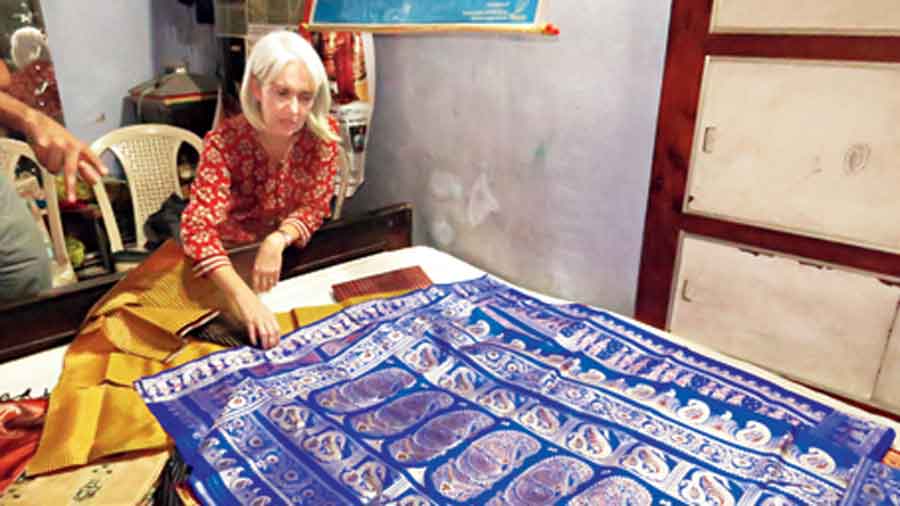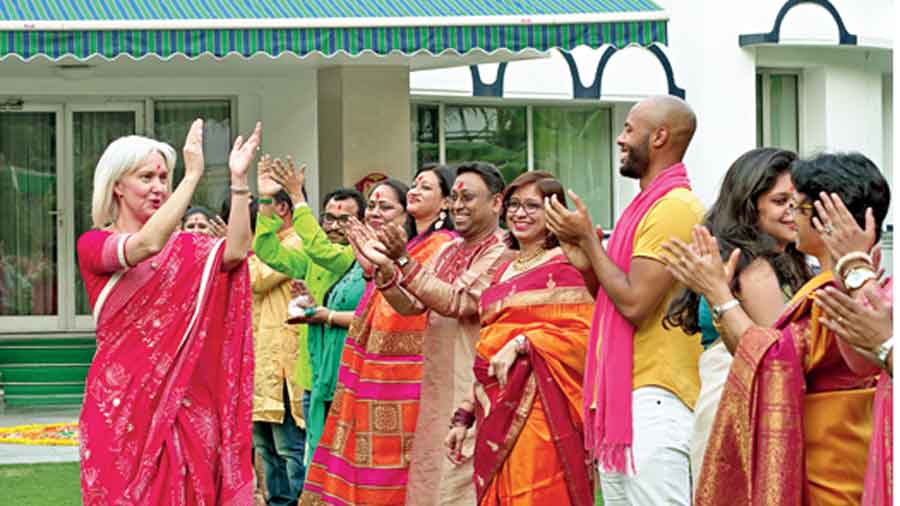As US consul general Patti Hoffman ends her tenure in Calcutta, she looks back on the three years she spent here, over a video call with The Telegraph.

Hoffman as a judge of CESC The Telegraph True Spirit Puja in 2018. Rashbehari Das
When do you leave town?
I will depart Calcutta in mid-July. I’ll return to Washington DC with the US Department of State to lead an office of security, transnational affairs and assistance, within the bureau of south and central Asian affairs. I feel fortunate to be able to continue to support the US-India comprehensive global strategic partnership.
You’d get to be near family.
Yes, being in Washington DC means I will be closer to Philadelphia, where most of my family and friends are. It’s a couple of hours’ drive.

Patti Hoffman on a walking tour of north Calcutta in February 2020. B. Halder
How challenging was running the consulate under lockdown?
When the pandemic started, our capacity to work virtually from home was limited. Most of us had not used virtual platforms. Virtual interactions increased our geographical outreach but can’t fully replace in-person meetings. One of our fundamental jobs as diplomats is to go out and make connections. The pandemic hindered all of that.
Have you resumed the visa interviews?
It is being phased in. Additional appointments for student visas have been added across India in July. Some slots are still open in end-August. We hope to open up more slots once we can bring additional staff. We are doing 150 interviews, give or take, in Calcutta per day. The goal is to match the 2019 numbers.

Hoffman at a Baluchori weaver’s studio in Bishnupur in 2019. Sudeshna Banerjee
When was the last time you were at the airport?
I flew to Imphal in March to attend the inauguration of the CDC-supported transgender health clinic. I also flew back to the US to visit family in November. Prior to that, in April last year we handled the repatriation flights, reuniting hundreds of Americans with their families in the US. That was a big exercise for us. We had to obtain special permission for them to travel by road from Bihar, Jharkhand, the Northeast, and throughout West Bengal to get them to the airport. From Calcutta, there were slightly over 200 flying out. We chartered flights to New Delhi and then a chartered United Airlines flight took them to New York, New Jersey.
The pandemic, in so many ways, has got the world closer.
It has been difficult for everyone. Just as India came to our aid when our healthcare system was under tremendous strain last year, we stand with India now. We deployed seven planeloads of life-saving supplies to India during the recent second wave. These carried tests, medicines, masks, oxygen…. The US government’s assistance amounted to $100million. The American people, through the private sector, donated an additional $400million worth of assistance. On top of that, the Centre for Disease Control (CDC) and USAID provided training and technical assistance. Along with Indian counterparts, they worked on strengthening laboratories, disease surveillance, emergency responses, infection prevention and control, vaccine roll-out, contact-tracing procedures…. They trained 10,000 frontline healthcare workers in India on sample collection and testing. Our new US International Development Finance Corporation is expanding manufacturing of Covid-19 vaccines by providing funding to Indian manufacturer Biological E. This will help them produce one billion doses by end-2022. Additionally, President Biden announced that the US will share 80 million doses of our own vaccine supply with the world and the purchase of half billion doses of Pfizer to donate to nations. Recently, at the G7 Summit, the leaders made a commitment to provide more than one billion additional doses to the world. The American government and the people are committed to ending the Covid-19 pandemic everywhere.

Patti Hoffman at the Calcutta airport during the repatriation of US citizens in April 2020
The US election was keenly followed in India this time. One reason perhaps was the vice-president being of Indian origin. Could you sense this local interest?
We observed the excitement on our social media platforms about vice-president Harris’ connection to India. People had a positive reaction to that. Personally, I was very excited to have our first woman vice-president as also the first with African-American and Indian roots. The election of someone like her with her diverse background is a step forward to ensuring an inclusive atmosphere in the US, which is a nation built by immigrants. A historic election, for sure.
What were your favourite activities in Calcutta in pre-pandemic times?
It was those that involved interacting with people — whether it was a programme put together by the consulate or the American Center, or a chamber of commerce event, meeting with government contacts, visiting schools, sharing a meal with the consular corps and other local friends, travelling throughout my district…. I also enjoyed cultural activities that exposed me to the rich and diverse Indian arts, music, dance and fashion. Park Street, especially in Christmas, is special. Also the walking tours here — Marble Palace, Fort William museum, Kalighat Temple, Mother House, serving lunch at Nirmal Hriday…. We went to Santiniketan, Darjeeling… I will take a lot of tea back to the US. I also saw the red panda at the zoo there.
The Telegraph had accompanied you on a walking tour of north Calcutta in February 2020.
Yes. I did a few heritage walks, like one through Kumartuli. That was a lot of fun. I was able to talk to artisans. Walking around, you are able to see more than if you were on a tour bus or a car. You get the pulse of the city and feel the population density. People give the city its vibrancy and their warmth makes Calcutta so special. There is also a lot of beautiful architecture here.
What would be the tips you would pass on to friends or colleagues visiting the city?
Come for Durga Puja. I had heard people talk about it when I arrived but it exceeded my expectations. It was an amazing experience that can’t be replicated anywhere in the world — such a positive, family-friendly atmosphere! I was impressed by the artistry of Durga puja. I’d tell them not to be intimidated by the crowds and to get out there and explore. Walking the historic streets and perusing local markets is a treat. Visit the Victoria Memorial and Indian Museum, local temples, take in some dance and music concerts too.
How much has Bengal contributed to your wardrobe?
A lot! (Laughs) You were with me on the tour of Bishnupur where I purchased a royal blue Baluchari sari from the weaver. I also bought a red-and-white traditional Bengali sari. I wore that to a sindur khela event. I also have two beautiful kantha stitch saris. They are really elegant. I have some local jewellery pieces as well. I also bought home decor pieces, like the terracotta items I got in Bishnupur, a number of dokra pieces, some pottery, shola pith and some historical photographs of Calcutta.
Any local dishes that you have developed a liking for?
I learnt that the term Indian food is a misnomer as the cuisine here is extremely diverse. I enjoyed sampling the wide variety of options. I enjoy mangoes, bekti fish, tea, mishti doi.… My eyes have been opened to the variety of vegetarian options.
Any regrets or misses for being stuck indoors for a year?
We all have these regrets and frustrations. My top regret is the time lost with friends and contacts. I could not visit some of the locales, like the Botanical Gardens, Murshidabad and Kaziranga park. I am also a big sports fan. I regret not having made it to Eden Gardens during a match. The unfinished business will give me reason to be back some day.
The US is allowing fully vaccinated people to take masks off. What would be the first thing you want to do on your return to a maskless life?
I took the Moderna vaccine. The State Department shipped it for us. Vaccination is the most productive way to end the pandemic. I am looking forward to socialising in groups when it is safe to do so. Interacting with people is a key element of being a diplomat.
